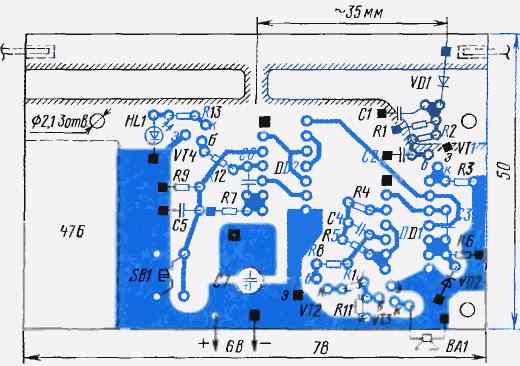The proposed device will then record the transmitter on a nearby cell phone.
Phone radiation is easy to detect by a high-frequency signal induced in a nearby antenna. It's enough to make a device, scheme of which is shown in Fig. 1.

Fig. 1 (click to enlarge)
Amplitude detector of microwave oscillations is the diode VD1. If the amplitude of the received signal is sufficiently large, the output voltage of the detector will open the transistor VT1 and the output of single-shot DD1.1-DD1.2, there is a pulse of a high logic level, which will allow the multivibrator DD1.3-DD1.4). The package is amplified by transistors VT2 and VT3 pulses will be played back by the head BA1 how loud click. So the device will respond to the output of the cell phone in the air even for a very short time.
Therefore, the device is supplemented by a memory node and indicator lights similar to those described by the author in the article "Electronic label ("Radio", 2002, № 11, pp. 33, 34).
The printed circuit Board of the device shown in Fig. 2. It is made from a two-sided foil fiberglass 1.5 mm thick. the Foil side of the plant parts used as the common wire and the screen, from it also formed the aerial vibrator. Compounds of the findings of the details with the common wire is shown blackened squares. A square with a bright dot in the center - charge passing through the jumper connecting the common wire terminals of the capacitor C7.

Fig. 2.
All resistors - MLT-0,125. Capacitors C1 - KD-1, C2-C6 - km-6 or K10-176, C7 - any oxide of suitable size with possibly a smaller leak (it should not affect the overall power consumption of the device). Led HL1 - anybody with enough bright glow when current 7...8 mA. Sound-emitting head BA1 - any impedance of 50 Ohms.
A very important element - diode VD1 - probably should have a smaller capacitance. Here are some of the matching parameters and the design of the diodes (in parentheses capacitance at zero bias): DA (0,35 pF), ADA (0,5 pF), ADB (0,35 pF), CDA, CDB (0,7 pF), CDA (at 0.4 pF), CDA (at 0.9 pF).
Length of half-wave vibrator for the 900 MHz band should be approximately 150 mm, and for 1800 MHz - half. However, experience has shown that in most cases the need for a full-sized antenna no.
Cell phone signal LX677 Ericsson a frequency of 860 MHz is securely taken to "print" the vibrator of the instrument from a distance of 0.15 m. If necessary the length of the antenna can be increased by soldering to the ends of the vibrator socket from pin connectors, as shown in Fig. 2. They injected cuts hard wires the right length. For the 900 MHz band - approximately 35 mm to 450 MHz to 110 mm. For extensions will require small holes in the side walls of the housing.
Extremely low current consumption in standby mode (less than 5 µa) allows you to use almost any source voltage of 6 V. the power Switch is not mandatory - energy battery lasts at least a year of continuous operation.
The housing can be glued from high impact polystyrene, dimensions - 85x57x25 mm.
Author: Yu. Vinogradov, Moscow; Published: www.cxem.net






